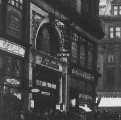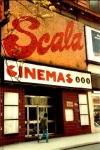The First Cinemas by James McKissack [Part 2]
The next cinema in which McKissack was involved was both more
substantial and salubrious – indeed it was an early example of a
city centre ‘picture palace’, complete with an orchestra,
tearooms and luxurious appointments. Opened in 1912,
La Scala was
located in Glasgow’s Sauchiehall Street, a bustling and
fashionable thoroughfare containing some of the city’s finest
department stores, theatres, several pre-existing cinemas and
Hengler’s Circus, an indoor circus amphitheatre. Thus, the street
was at the heart of the Glasgow entertainment scene and almost every
tram service was routed through it. Almost directly opposite La Scala
stood
The Picture House – Scotland’s first true
‘picture palace’, opened in 1910.
 |
La Scala was converted from a large shop and warehouse retailing music
and musical instruments (which explains the excess of windows in its
sandstone frontage). The rebuilding involved something of a
‘façade retention’ many decades before such tactics
became commonplace and this was probably to save money, rather than for
any more selfish reasons (like building conservation). On this project,
McKissack worked alongside another Glasgow architect who had found a
niche in cinema design work, Neil C. Duff of Duff and Cairns. As with
McKissack’s firm Duff’s had previously specialised in
churches, but went on to design cinemas almost exclusively. |
Incidentally, Duff had only recently designed a smaller cinema for the
same owners as La Scala, Glasgow Photo Playhouse Ltd. This was the
Regent (opened in 1911) in the city’s Renfield Street.
The architects inserted a relatively narrow entrance to La Scala
between shop units (a frequent ploy in such city centre locations
either to make extra money through leasing out the shops or to lessen
the cinema’s rateable value by using less expensive street
frontage space). Even so, advertisement was required to tell passers by
that this was a venue of luxury, taste, refinement and, above all,
respectability. Thus, the entrance portico consisted of mahogany doors,
flanked by ivory-painted cast iron composite columns with enriched
shafts featuring strap-work in low relief. Above, there was an arch
containing a leaded glass window and the whole ensemble was brightly
illuminated by white electric bulbs. Signage was also important and so
the cinema’s name was spelled out both horizontally across the
façade and vertically by means of a protruding sign, thus
enabling the cinema to be pinpointed from up and down Sauchiehall
Street, amid the maelstrom of tramcars, traffic and pedestrians.
The design incorporated a large entrance hall with a carved wooden pay-
box; from this a warren of passageways and staircases took the patrons
to the auditorium, much like many theatre designs, which still exist
today such as HMS Theatre, Aberdeen.
The auditorium was rectangular and
airy, with a balcony, with side- slips, suspended on columns, which
must have spoiled the view of the screen for those in the rear stalls.
|
 |
The building was, of course, a compromise and there may have been a
limit to how large a span could have been accommodated in an existing
structure. Even so, The Glasgow Herald of 18 October 1912, recording
the opening, noted the otherwise excellent appointments:
‘At the rear of the central gallery, commanding an excellent view
of the screen, boxes have been fitted ... There are tea rooms and tea
lounges both in the area (stalls) and in the gallery (balcony) so
situated that patrons can enjoy the entertainment while partaking of
the refreshments.’
It was thought romantic to take high tea while watching a film, and the
tea rooms with their shaded lighting soon became popular with courting
couples. As Scottish Country Life noted in 1928, this feature became
the outstanding attraction of La Scala:
‘When the theatre was opened, one heard the remark that its
catering department would not pay. That prophecy has been entirely
falsified as the cafe at La Scala has proved a most popular rendezvous
not only with residents in the city but also for their country cousins.
It is a decided advantage for busy people to have luncheon or tea and
at the same time to see what is being portrayed on the screen
...’
Cinemas such as La Scala aimed to attract an upmarket audience from
Glasgow’s more salubrious areas – patrons who would never
have considered visiting premises such as the
Eglinton Electreum, but
rather whose points of reference for design values appropriate to an
entertainment venue would have been a theatre or concert hall. Comfort
was of great importance, as was cleanliness and a high quality of
furnishings and decoration.
 |
Little survives to show how La
Scala’s interior originally looked as the building was totally
reconstructed and enlarged in 1936 to a design by Alister G. MacDonald
(the son of the Labour prime minister).
The original decoration,
however, was by Guthrie and Wells, a fashionable Glasgow firm that also
decorated Cranston’s premises in Renfield Street (within a shell
by James Miller).
La Scala survived [after a tripling] until mid-1984 and the Glasgow branch of
Waterstone’s has replaced it, behind the same Victorian
façade, which of course pre-dates the cinema. |
McKissack’s next cinema was an entirely new building – the
Silver Cinema in Nicholson Square in Edinburgh. Although little
evidence has been found about this venue, The Last Picture Showsby Brendan Thomas records that it too was rather upmarket and
seemingly aimed to attract ‘posh Southsiders.’ Its
façade was symmetrical and of Craigleith stone. On either side
of the arched entranceway, there was a bell tower. One year after first
opening, the cinema was re-named the Lyric and continued as such until
its closure. Plans were lodged, however, in 1934 for a proposed
rebuilding and enlargement, but these were never carried out. It is not
clear what architect was involved in this abortive scheme.
In 1916, McKissack was employed by Miss Catherine Cranston, the doyenne
of Glasgow tea room owners, to act as ‘ Film Advisor’ to
her new cinema venture in Renfield Street. The cinema was part of an
entertainment complex called Cranston’s De Luxe which contained
several tea rooms, a restaurant, billiard rooms and a cinema, all
within a beaux arts style block faced in white faience tiling and
designed by James Miller.
McKissack must, therefore, have been rather a
well – known film enthusiast for her firm to rely on his
selections, as she promoted an upmarket image for this her only cinema
using the slogans ‘Cranston’s Programmes are Always
the Best’ and ‘Cranston’s Pictures are First Run
Glasgow.’ |
 |
A person with a wide range of talents, or
interests can be described as a renaissance man, a description which
certainly seems appropriate when applied to James McKissack. It would
seem, however, that his chief interest was cinema, and he was to
channel much effort into designing buildings, which would in different
ways attempt enhance the film-going experience for the public.